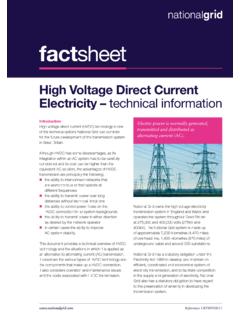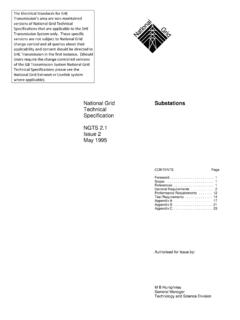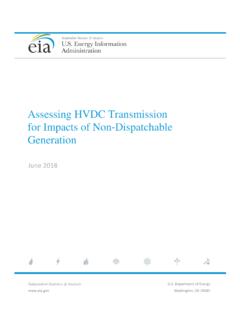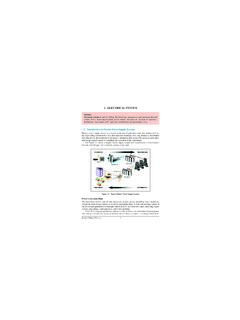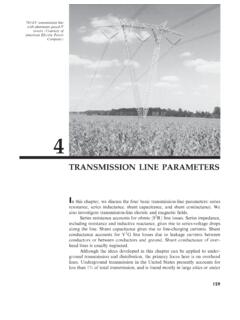Transcription of Undergrounding high voltage electricity transmission lines
1 Undergrounding high voltage electricity transmission linesThe technical issuesContents Introduction 03 National Grid electricity transmission 03 an overview Section1 Insulating underground cables 042 Capital costs for installation of 05 underground cables3 Underground cable technologies 064 Planning and environmental issues for 08 underground cables5 Land use restrictions over cable routes 096 Operation, maintenance, refurbishment 10 and up-rating cables7 Cable installation methods 11 Direct buried cables 11 Direct buried cable installation 12 Ducted method 13 Surface troughs 13 Deep bore tunnels 14 Cut and cover tunnels 158 Components of underground 16 cable systems Cable sealing end compounds 16 Joint bays 16 Stop joints 17 Water cooling 17 Reactive compensation 179 Electric and Magnetic Fields (EMFs) 18 from underground cablesFront cover photo.
2 National Grid works with Arup to deliver London Power TunnelsIntroductionNational Grid owns the high voltage electricity transmission system in England and Wales and operates the system throughout Great Britain at 275,000 and 400,000 volts (275kV and 400kV). This transmission system is made up of approximately 7,200 kilometres (4,470 miles) of overhead line , 1,400 kilometres (870 miles) of underground cable and about 330 planning policy relating to electricity infrastructure can be found in two National Policy Statements (NPS) the Overarching NPS for Energy (EN-1) and, more specifically, the NPS for electricity Networks Infrastructure (EN-5). These are the main documents that inform decision making on major infrastructure projects.
3 Therefore, they provide National Grid with important guidance when considering whether to use overhead lines or underground cables. National Grid has a statutory obligation under the electricity Act 1989 to develop and maintain an efficient, coordinated and economical system of electricity transmission , and to facilitate competition in the supply and generation of that electricity . The company also has a statutory obligation to have regard to the preservation of amenity when developing electricity lines or undertaking other works in connection with electricity transmission infrastructure. In doing so National Grid has to make careful and informed judgements on the relative merits of both overhead lines and underground terms of reliability, capability, cost, construction impacts and land use, overhead lines do have advantages when compared to underground cables.
4 However, a significant benefit of Undergrounding cables is the reduction in visual impact. In certain areas, such as protected landscapes, this benefit could be a primary consideration and outweigh disadvantages of Undergrounding such as restrictions on land use and the impact on ecological and archaeological sites. National Grid considers the views and requirements of its customers and undertakes extensive stakeholder consultation before deciding which solution to take 03 The purpose of this document is to provide information about the technical merits and challenges associated with Undergrounding high voltage electricity lines , compared with installing overhead lines .
5 Overall, there are a number of issues that make the Undergrounding option more technically challenging and expensive. However, despite the costs and technical challenges, there are circumstances in which underground cables are a more preferable option than overhead cables. This document explains the cost and potential impact on the environment of cable installations. It explains the cable types available and the various installation methods, as well as the separate components that make up an underground Grid electricity transmission an overviewConductors that transmit electricity need to be electrically insulated. One major difference between overhead lines and underground cables is the way they are insulated.
6 Overhead lines are insulated by air, while underground cable conductors are wrapped in layers of insulating material. Air is the simplest and cheapest insulation and the heat produced by the electricity flowing through the bare overhead conductors is removed by the flow of air over the conductors. When conductors are buried underground, robust insulation is needed to withstand the very high voltage . The insulation method depends upon the type of cable used (see section on Underground cable technologies ).Underground cables, because of the insulation and surrounding environment, tend to retain the heat produced in the copper/aluminium conductor. This heat then has to be dissipated to the surrounding environment.
7 To compensate for this, underground cables are generally bigger to reduce their electrical resistance and heat produced. How the heat produced is dissipated will depend upon the cable installation method. For direct buried cables each cable needs to be well-spaced from others for good heat dissipation. To match overhead line thermal performance for a 400kV double circuit, as many as 12 separate cables in four separate trenches may be needed, resulting in a work area up to 65m wide. In addition, water cooling may be used (see section on Components of underground cable systems ). For cables installed in deep bore tunnels, cable cooling is provided by forced air ventilation or water designing a cable system, there are a number of factors to consider relating to the physical environment of the cable, which will help optimise their electrical performance.
8 These include ensuring: Adequate heat dissipation to prevent overheating and subsequent reduction in its capacity for carrying current (cable rating) Adequate physical protection to protect the cable from damage and to ensure it is not a potential danger to people while in service Proper access for maintenance crews to the cable to inspect, repair or replace Insulating underground cablesA typical cable installation methodCables are laid in a trench in groups of three. Each cable trench is a metre across and over a metre deepFill-in must be well compacted to aid the removal of heatConcrete cable covers prevent accidental damage to cables and electrocutionCement-bound sandThe conductor is much thicker than for an overhead cableTough plastic cover protects against corrosionAluminium or lead sheath to retain insulating fluidThe conductor is insulated by a thick wrapping of fluid-impregnated paper.
9 The fluid is kept under pressure by fluid tanks along the cable routePage 042. Capital costs for installation of underground cablesThe costs of underground cable systems vary and have been the subject of much debate and discussion. In January 2012 the Institute of Engineering and Technology (IET) and Parsons Brinkerhoff published the findings of an independent study into the costs of new electricity transmission infrastructure. The report analysed the costs of installing and maintaining new high voltage transmission circuits under the ground, under the sea and overhead. The report found that, excluding build costs, the cost of operation, maintenance and energy losses over the life of the connection was broadly the same for Undergrounding and overhead lines .
10 However, the report also concluded that the capital build costs on their own vary greatly, depending on terrain, route length and power copy of the report can be found on the IET website ( ). While the study went into a great deal of detail, the report recognised that costs and cost differentials between different technologies will vary depending on length, power, voltage and ground conditions. It concluded that underground cables are always more expensive when compared to equivalent overhead lines . A major element of this cost differential is accounted for by the cable itself. The underground conductor has to be bigger than its overhead counterpart to reduce its electrical resistance and hence the heat produced.


